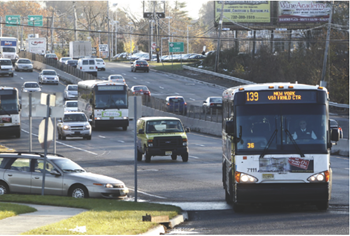Household Travel Survey
To gather information on travel behaviors and patterns, the NJTPA and the New York Metropolitan Transportation Council (NYMTC) partnered on a large-scale effort to survey the households in the NY/NJ/CT metropolitan area. The main survey began in late September 2010 and was completed in November 2011. The survey included 18,965 households—7,574 in the NJTPA region—in the 28-county, tristate metropolitan region.
 The 2010/2011 Regional Household Travel Survey (RHTS) is a follow-up to one administered during 1997/98. Since the late 1990’s this region has experienced some significant changes that might impact travel behaviors. These changes include:
The 2010/2011 Regional Household Travel Survey (RHTS) is a follow-up to one administered during 1997/98. Since the late 1990’s this region has experienced some significant changes that might impact travel behaviors. These changes include:
- Major transit system expansion (Hudson-Bergen Light Rail, Secaucus Transfer, Newark Airport service, Midtown Direct)
- Fare structure changes (Metrocard)
- Economic shifts (two recessions)
- Regional land development pattern changes (e.g., Jersey city “Gold Coast”, continued suburban expansion)
- Technological changes (e.g., increased cell phone usage, GPS, internet, increased availability of real-time travel information)
To provide continuity with the 1997/98 survey the updated survey asked participants similar questions.
Some of the key findings show:
- Most general travel patterns remained similar to those found in the 1997/98 survey.
- The use of GPS devices to collect data provided this survey with an improved accounting of trips, especially short, non-motorized trips.
- People defining themselves as part-time employed or homemakers make the most trips (over five trips per weekday). The presence of children is also a significant factor in trip-making
- Most trips (86%) are made within the county of residence or to an adjoining county. Hudson County has the highest percentage of work trips in Manhattan, over ¼ of all work trips.
- Hudson County by far has the highest percentage of trips made by non-motorized and transit trip modes (30 percent and 20 percent respectively or 50 percent overall—in the region. The next highest county is Essex with 17 percent non-motorized and 11 percent transit trips (28 percent overall.
- Hudson was the only county in the state to have less than 70 percent of residents making trips by auto and it ranked lowest overall in that category at 47 percent.
- There is a clear inverse relationship between density in the region and the use of the auto and non-motorized modes; as density rises, auto use decreases while non-motorized use increases.
- Only ¼ of all trips are work trips; however work trips tend to be longer and more likely to be made by single occupancy vehicles.
- Hudson County tend to make the shortest trips by distance but the longest trips by time. This is likely due to the heavy use of slower modes such as walking and transit.
A Final Report is available, along with an executive summary of the results . A public version of the dataset along with a data users manual are also available and can be accessed after acceptance of the data disclaimer.
For any additional inquiries, please contact Keith Miller at (973) 639-8444 or [email protected].